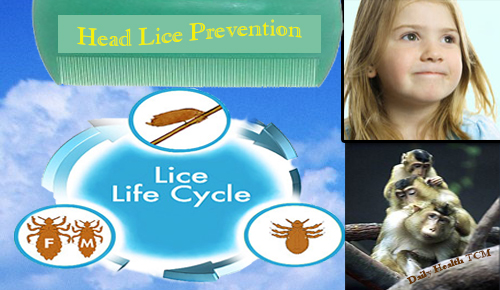Head lice are small, wingless insects that are gray or brown. It is a parasite that feeds by sucking blood from the human scalp.
The size of newly hatched lice are about 1 mm (about the size of the head of a pin), and full adult louse is about 3 mm (slightly smaller than the size of a match head). Head lice take between 6 to 14 days to become fully grown, then the female will give birth to sexual relations and eggs on the scalp.
After seven to 10 days, the baby lice hatch and the empty eggshells remain glued in place. These remains are known as nits. Nits are white and become more noticeable as the hair grows and carries them away from the scalp. Sometimes it is thought to dandruff, but can be distinguished because it sticks to the hair and difficult to be deprived. Eggs take 7 to 19 days to hatch and remained on egg shells attached to the hair shaft. Lice can survive up to 21 days, and adult female can produce as many as 56 eggs in a relationship type.
A summary of the life cycle of head lice
Day 0 – eggs attached to the hair
Day 6 – egg begin to hatch
Day 8 – the first child born bug
Day 11 – the second child born lice
Day 16 – the third child was born lice
Day 17 – nymphs become adult fleas and begin to spread
Day 18 – adult female fleas begin laying eggs
Day 19 – adult female louse can lay 4-8 the next day for 16 days
Day 33 – fleas begin to die
How do I know that my child gets head lice?
Head lice can camouflage well in the hair and are difficult to detect. Often thought that itching is the first sign of head lice, but head louse can live for up to three months without a chief cause itching. Other tangible signs include :
- glossy white eggs attached to the hair close to the scalp, often behind the ears and back of the neck;
- shiny white empty during which there are quite a long way up hair shaft;
- adult lice can be seen on the scalp / hair;
- redness in the back of the neck due to irritation from bug faeces.
You should try brushing your child to collect a piece of white paper to see if there are live lice are falling. This is not one hundred percent effective, usually because of a bug that will run an tampered with. The best way to ensure your child is not being attacked is to carry out the destruction of the eggs on the wet hair with a fine-toothed comb nits.
Do not use any insecticide treatment on your child’s scalp until you find live lice.
How are infected with head lice?
Head lice can not jump, fly or swim and are spread by head-to-head contact, climbing from the hair of an infected person to the hair of someone else.
That is why it is particularly widespread among children aged 4 to 11 years, who often play together closely during the pre-school or primary school. As a parents, schoolchildren or siblings of a child this age group also have a risk.
There are many misconceptions thought of head lice prefer with a long hair and rarely washed, but it is found in the hair of all types, lengths and conditions. Sometimes people think that it can be spread when near a clothes or linen bedding, towels and caps bearing lice, and thinks it is not right that the goods should be washed or smoked.
Another way to destroy lice
Electronic brush
A fine-toothed comb using battery power, which will turn off the lice with electric shocks, can be purchased. Usually it is quite expensive and not save to use for hair wet, so it’s likely a bug will move fast in dry hair and apart from being detected.
Its natural
Shampoo and lotions contain essential oils such as tea tree and rosemary, sometimes recommend, but there is no scientific evidence that is effective. It is important to remember that essential oils are sometimes very hard and unsafe to use because many times can cause scalp irritation.
Kerosene, vinegar, hair bleach, antibiotics or garlic is not recommended.

